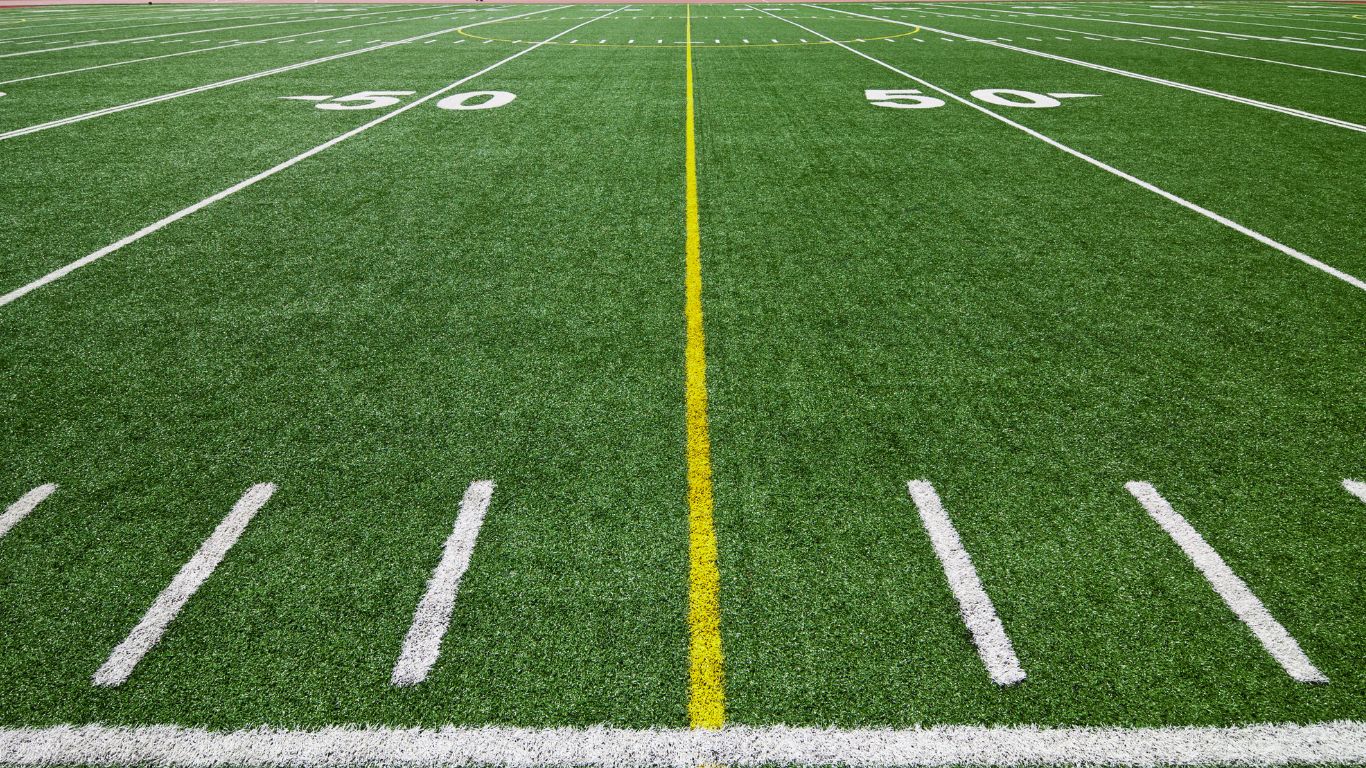A football field is 53.33 yards (160 feet) wide. The width of a standard football field is 53.33 yards (160 feet).
The dimensions of a football field are standardized, with the width set at 53. 33 yards and the length at 120 yards. The width of the field is significant in determining the strategies and tactics used by the teams during a game.
Understanding the exact dimensions helps players, coaches, and fans appreciate the scale of the game and the skills required to compete at the highest level. Whether it’s a professional match or a casual game, the width of a football field plays a crucial role in shaping the dynamics of the sport. With this knowledge, fans and players can gain a greater appreciation for the intricacies and challenges of football.

Credit: www.cleveland.com
The Length Of A Football Field
A football field is much more than just the area where the game is played. The field’s dimensions play a crucial role in determining the flow of the game and its outcome. Understanding the length of a football field and its components provides insights into the dynamics of the sport.
End Zones
The end zones are vital sections of the football field. They are located at both ends of the field, each measuring 10 yards in length. These zones are where the players strive to advance the football to score touchdowns, a pivotal aspect of the game.
Playing Field
The playing field itself spans a length of 100 yards. It includes the end zones, making the total length of a standard football field 120 yards. This vast expanse serves as the battleground for players to execute strategic plays and demonstrate their skills.
These dimensions greatly impact how the game unfolds, influencing teams’ tactics and players’ positioning.
Credit: apnews.com
The Width Of A Football Field
When it comes to American football, the dimensions of the playing field are critical to the game’s strategy and overall play. One important aspect of a football field’s dimensions is its width, which affects how the game is played and enjoyed. The width of a football field is determined by several key elements, including the sidelines and hash marks. Understanding the dimensions of a football field can deepen your appreciation for the game and enhance your understanding of how it is played.
Sidelines
The sidelines of a football field are a defining feature, not just for the players, but also for fans and officials. The standard width of a football field from sideline to sideline is 160 feet. This distance provides ample space for players to maneuver and compete while also accommodating the referees and other officials who oversee the game.
Hash Marks
Hash marks play a crucial role in demarcating the width of the playing area. These marks are positioned on the field at intervals of one yard apart. Running parallel to the sidelines, hash marks help to delineate the width of the field and are particularly important for determining the placement of the ball after a play.
Additional Dimensions
In addition to the width of a football field, there are a few other important dimensions that contribute to the overall structure and playing experience. These additional dimensions include the goal posts and bench areas. Let’s dive in to learn more about each of these elements.
Goal Posts
When it comes to football, the goal posts are a crucial part of the game. They are positioned at each end of the field, serving as the target for teams to score points. The goal posts consist of two vertical poles that are connected at the top by a horizontal crossbar. The width between the inner edges of the goal posts is 18.5 feet, which is equivalent to 5.64 meters.
The height of the goal posts is 30 feet, or 9.14 meters, from the ground to the top of the crossbar. The distance between the ground and the bottom of the crossbar is 10 feet, or 3.05 meters. These dimensions provide a visual reference for players as they aim to kick the ball between the uprights.
Bench Areas
Another important aspect of a football field is the bench areas, where teams and coaches gather during the game. These areas are located on opposite sides of the field and provide a space for players to rest, strategize, and receive guidance from their coaches.
The bench areas typically consist of a designated space along the sidelines, marked by a solid white line. The width of the bench areas can vary, but they are generally around 6 feet (or 1.83 meters) in width. This allows ample room for players, coaches, and staff to move around comfortably.
Within the bench areas, you’ll often find additional amenities such as seating, shelters for protection from the elements, and areas for medical personnel. These facilities further enhance the overall experience for both players and spectators.
Now that we’ve explored the additional dimensions of a football field, including the goal posts and bench areas, you have a more comprehensive understanding of the various elements that contribute to the game. These dimensions play a significant role in determining the layout and functionality of the field, as well as the overall experience for everyone involved.

Credit: www.mlive.com
Comparison To Other Sports
When it comes to the size of a football field, it’s important to understand how it compares to other popular sports. Let’s take a closer look at the dimensions of a football field and how it measures up to the fields used in basketball and soccer.
Basketball Court
A basketball court, also known as a basketball field, is significantly smaller than a football field. While football fields have a rectangular shape, basketball courts are rectangular as well but have different dimensions. The standard size of a basketball court is approximately 94 feet in length and 50 feet in width.
Soccer Field
When it comes to soccer, the field known as a soccer field or a football pitch is quite similar in shape to a football field. However, the dimensions of a soccer field can vary depending on the level of play. The average size of a full-size soccer field for professional matches is about 100-130 yards in length and 50-100 yards in width.
Here’s a comparison of the dimensions of a football field, a basketball court, and a soccer field:
| Length | Width | |
|---|---|---|
| Football Field | 100 yards | 53.3 yards |
| Basketball Court | 94 feet | 50 feet |
| Soccer Field | 100-130 yards | 50-100 yards |
As you can see from the table, a football field is the largest in terms of both length and width, followed by a soccer field. A basketball court is the smallest of the three, making it a more compact playing area.
Understanding the dimensions of a football field in comparison to other sports can help you visualize the size and scale of the game. Whether you’re a player, a fan, or simply interested in the sport, knowing the field’s dimensions adds a new perspective to your understanding of the game.
Considerations For Players And Coaches
Considerations for Players and Coaches
When it comes to playing football, the size of the field plays a crucial role in shaping game strategies and training techniques. The dimensions of a football field have a direct impact on how players and coaches approach the game. Here are some key considerations for players and coaches to keep in mind:
Game Strategies
The width of a football field, which is typically 53 1/3 yards (160 feet) for both high school and professional games, has significant implications for game strategies. The wide expanse of the field allows for various offensive and defensive approaches. Coaches and players need to take advantage of the width by employing wide-ranging passing plays or utilizing the sideline for effective defensive positioning. The wide space also enables teams to spread out their offensive formations, creating opportunities for quick passes and lateral movements.
On the defensive end, players must focus on preventing opponents from exploiting the width of the field. By covering larger areas, defenders can thwart wide receiver routes and intercept long passes. Additionally, the wide field dimensions necessitate effective communication and coordination among teammates to ensure seamless defensive coverage throughout the game.
Implications For Training
The width of a football field has considerable implications when it comes to training techniques. For players, training drills should focus on maximizing their ability to cover ground quickly, especially for positions responsible for sideline-to-sideline coverage. Quick lateral movements, acceleration, and agility become key attributes to develop during training.
Training sessions can also include exercises that simulate the game scenario, where the wide field is taken into account. By setting up practice drills with broader distances, players can adapt to the wide dimensions and hone their decision-making skills accordingly. Moreover, coaches can place an emphasis on conditioning drills, aiming to improve players’ endurance and stamina, especially for those who need to cover large territories during the game.
In conclusion, when it comes to football, the width of the field greatly influences game strategies and training methods. Players and coaches must understand and adapt to the wider dimensions by utilizing various offensive and defensive approaches. By implementing strategic training techniques, athletes can enhance their ability to cover the wide expanse of the field. Ultimately, considering the width of the football field is crucial for achieving success on both game day and in training sessions.
Frequently Asked Questions
How Wide Is A Football Field?
A football field is 53. 33 yards wide, which is equivalent to 160 feet or 48. 76 meters. It provides enough space for players to maneuver and make strategic plays during the game. The width ensures a fair and balanced playing field for both teams.
What Is The Standard Width Of A Football Field?
The standard width of a football field is 53. 33 yards, as mandated by the National Football League (NFL) and other governing bodies. This width allows for proper gameplay, accommodating the movements of players and enabling effective execution of various strategies.
Why Is The Width Of A Football Field Important?
The width of a football field is crucial as it impacts the style of play and the strategies employed by teams. A wider field allows for more open gameplay and encourages long passes and wide runs. Conversely, a narrower field requires more precise passing and promotes tighter, short-range tactics.
The width contributes to the overall dynamics and excitement of the game.
Conclusion
So, now you know the dimensions of a football field. It measures 100 yards in length and 53. 33 yards in width. Understanding the size of a football field is essential for players, coaches, and fans alike. Whether you’re playing the sport or watching a game, this knowledge adds to your overall appreciation and comprehension of the game.
So, the next time you’re at a football stadium or watching a game on TV, you can impress those around you with your understanding of the dimensions of the field. Happy football watching!








